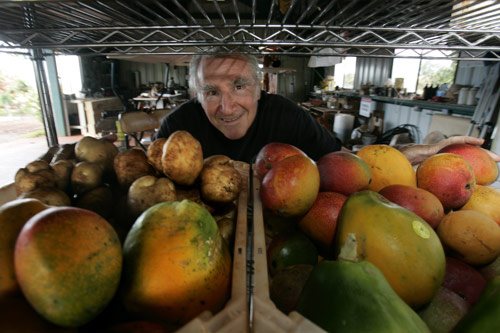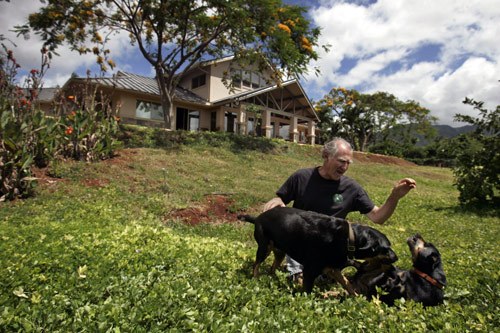Estates sprout on farmland

Al Santoro displayed some of the mangoes and potatoes he harvested on his organic farm in a five-acre agricultural subdivision in Waialua.

Santoro says even though some owners might have only two horses on their land, such as the one above, and earn no money from farming, they are still legal.

Santoro has neighbors on farmland with big homes and no substantive farms.

Santoro played with his dogs.




Al Santoro lives in a 2,700-square-foot house and operates Oahu’s largest certified organic farm. Some of his neighbors have homes more than twice as big but engage in little or no commercial farming. Yet all the homes in Santoro’s Waialua neighborhood are approved "farm dwellings" on agricultural land under state and county rules.
The allowance of what sometimes amount to rural estates with a couple of horses or rows of palm trees has long existed under loose wording of the state’s 1961 Land Use Act and county rules.
The ill-defined regulations mostly resulted in housing subdivisions on the neighbor islands. Yet in recent years the potential to lose big chunks of Oahu farmland to ag subdivisions without much connection to farming has grown as large tracts of farmland have been put up for sale by Dole Food Co., James Campbell Co. and the Galbraith Estate on an island with some of the highest residential property prices.
Now the Honolulu City Council is taking on the issue through a bill that aims to clamp down on the lax regulations. The concern is the so-called "gentleman farms" often drive up prices and reduce availability of land for commercial farming.
The bill, introduced earlier this year, has yet to be discussed at a public hearing. However, written testimony has already been submitted in opposition to the measure largely because of a key point that would restrict the size of homes permitted on ag land to 1,500 square feet.
The rationale for the rule is that limiting homes to such a size would provide a reasonable residence for farming families yet discourage the purchase and development of farm lots for nonfarm luxury country living.
Don't miss out on what's happening!
Stay in touch with breaking news, as it happens, conveniently in your email inbox. It's FREE!
Some City Council members acknowledge that the measure, Bill 23, is not a good solution, but they hope a debate will yield a workable alternative that prevents growth of gentlemen farms on Oahu.
"This vehicle is important because it will allow and guide some of the dialogue," said City Council Chairman Todd Apo. "We need the discussion. It’s a difficult thing to codify in law."
As it is now, state land use rules generally permit one or two dwellings on ag lots as small as two acres if they are "used in connection with a farm."
What constitutes a farm is not defined, so officials have little basis to reject a farm plan even if it amounts to a vegetable garden, a grove of coconut trees or a pasture for a couple of horses.
Bill 23’s genesis is tied to the work of an agriculture development task force the City Council established in 2004. The task force issued recommendations that resulted in a resolution the City Council adopted in 2009 and used to produce a draft of Bill 23.
Among the recommendations for ag lots were limiting a home’s size to 1,500 square feet, requiring the homeowner generate at least $10,000 in annual revenue from farming and requiring three years of such farm revenue before a home could be built on the land.
After discussion with the City Department of Planning and Permitting, the Council eliminated provisions pertaining to farm revenue but retained the home size limit.
Planning and Permitting supported the home size limit but suggested it be incorporated in a separate measure, Bill 24, that would make more detailed refinements to the county’s Land Use Ordinance.
The home size limit, however, is not supported by the state Department of Agriculture, and Bills 23 and 24 drew heavy criticism from Santoro and other individuals over the issue.
Mark Song, a physician from Newport Coast, Calif., who owns a 2-acre ag lot on Oahu, views the proposed restriction as discriminatory.
"I purchased this lot solely for the purpose of retiring there, building a home for my family and embarking upon an agricultural endeavor," he said in written testimony.
Dexter Hashimoto, a former Hawaii resident living on the mainland, said he seeks to buy an ag lot on which to move home and start a farm with help from local family members.
"We don’t understand how limiting the size of a house is supposed to spur agricultural production," he said in written testimony.
A look at Santoro’s neighborhood — an ag subdivision with 15 mostly 5-acre lots called Poamoho Estates — illustrates the point.
Of the 15 lots, only two appear to have active commercial agricultural operations. One is a plant rental and nursery accompanied by a 1,900-square-foot house. The other is the organic farm operated by Santoro, who lives in his 2,700-square-foot house with his wife, Joan.
A third property has numerous young fruit trees and an 864-square-foot house.
"What the hell does a house’s size have to do with farm activity?" Santoro said. "I’m offended. I’m no gentleman farmer. I work every day. We sell everything we grow."
Santoro was the first resident of Poamoho Estates and built his house at the same time he planted his land with banana, lemon, lychee, lilikoi, papaya, mango, longan, avocado, breadfruit and other fruits and vegetables.
Santoro, a U.S. Navy retiree, finished the home in 2001 and began operating Poamoho Organic Produce, which has more than 850 trees today.
Customers include supermarkets, hotels, restaurants and individuals like Nicolas Sariban, who stopped by last week to buy a 5-gallon bucket of limes for his catering company Happy’s Hawaii.
"Take what you want and leave me some money," Santoro told Sariban. "Do what you think is fair."
Yet while Poamoho Estates attracted Santoro as its first resident, the subdivision’s appeal shifted as Hawaii’s real estate market boomed in the mid-2000s, and lots often were marketed as luxury estates.
One neighbor is finishing a roughly 6,000-square-foot house, according to building permits, and has two horses.
Another home measuring about 3,500 square feet also has two horses in its yard.
Four homes are under construction, including one with a grove of recently planted coffee trees.
One lot dotted with palm and fruit trees was on the market earlier this year for $1.25 million. The property has no dwelling, but comes with architectural plans for a Balinese-style home created by an "acclaimed" designer. The seller paid $700,000 for the lot in 2004.
Critics of gentleman farm estates say they inflate the value of farmland and price serious farmers out of the market. Gentleman farms can also benefit from property tax exemptions and lower water rates.
Santoro said county rules for wide streets, streetlights and other infrastructure contribute to pricey ag subdivision prices. But he also said ag subdivision reform that expands farming and food production is needed, though he is not sure what shape the reform should take.
The state Department of Agriculture supports reform but not Bill 23. Instead, the department suggested that the city address what constitutes a sufficient amount of agricultural activity on ag lots with farm dwellings.
Sandra Lee Kunimoto, department director, said in written testimony that the city should require evidence of agricultural production, perhaps tied to farm-related capital spending or revenue.
Councilman Donovan Dela Cruz said it is obvious that Bill 23 as presently written lacks merit, but he hopes a solution will arise from it.
Dela Cruz said he believes the answer lies in creation of rural or county zoning that would allow nonfarm residences on large ag lots that are marginally productive for farming because of soil or water limitations.
Dela Cruz also said he hopes the effort by the state and county to encourage voluntary protection of privately owned farmland under the state’s Important Agricultural Lands law passed in 2005 will lessen pressure on farmland being turned into ag subdivisions with questionable farming.
The recently passed city budget contains $500,000 to identify important ag land on Oahu. Still, it is up to private landowners whether to seek the designation in return for benefits under the law.
In addition, the important ag lands law allows for farm dwellings provided that a home is used exclusively by farmers and immediate family members who actively and currently farm the land. A "farm" is not defined in the law, though the Agriculture Department has the authority to approve or deny plans for homes based on whether they are tied to active farming.




